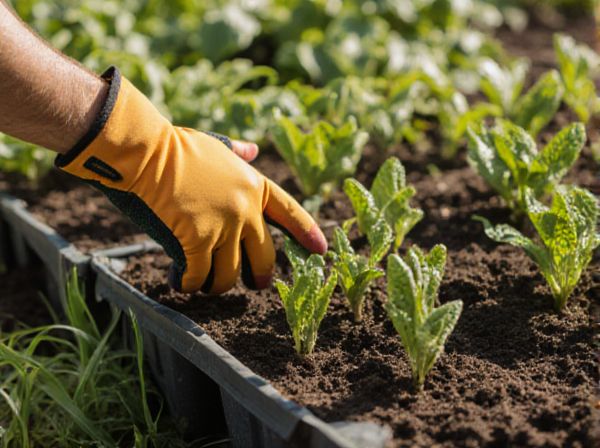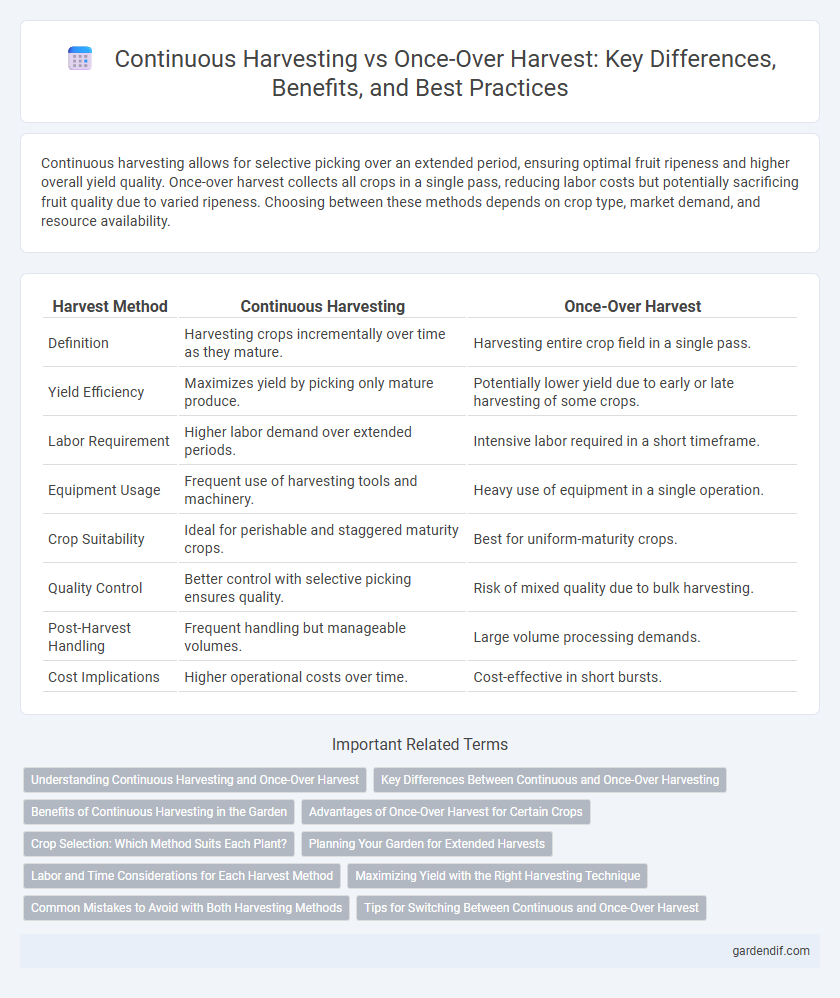
Continuous Harvesting vs Once-Over Harvest Illustration
Continuous harvesting allows for selective picking over an extended period, ensuring optimal fruit ripeness and higher overall yield quality. Once-over harvest collects all crops in a single pass, reducing labor costs but potentially sacrificing fruit quality due to varied ripeness. Choosing between these methods depends on crop type, market demand, and resource availability.
Table of Comparison
| Harvest Method | Continuous Harvesting | Once-Over Harvest |
|---|---|---|
| Definition | Harvesting crops incrementally over time as they mature. | Harvesting entire crop field in a single pass. |
| Yield Efficiency | Maximizes yield by picking only mature produce. | Potentially lower yield due to early or late harvesting of some crops. |
| Labor Requirement | Higher labor demand over extended periods. | Intensive labor required in a short timeframe. |
| Equipment Usage | Frequent use of harvesting tools and machinery. | Heavy use of equipment in a single operation. |
| Crop Suitability | Ideal for perishable and staggered maturity crops. | Best for uniform-maturity crops. |
| Quality Control | Better control with selective picking ensures quality. | Risk of mixed quality due to bulk harvesting. |
| Post-Harvest Handling | Frequent handling but manageable volumes. | Large volume processing demands. |
| Cost Implications | Higher operational costs over time. | Cost-effective in short bursts. |
Understanding Continuous Harvesting and Once-Over Harvest
Continuous harvesting involves regularly collecting crops throughout the growing season, optimizing yield by reducing crop loss and allowing for fresher produce delivery. Once-over harvest entails gathering the entire crop in a single event, which simplifies logistics but can increase waste due to varying ripeness levels. Understanding these methods helps farmers balance efficiency, crop quality, and market demands for better resource management.
Key Differences Between Continuous and Once-Over Harvesting
Continuous harvesting involves regularly collecting mature crops throughout the growing season, reducing crop loss and allowing for fresher produce availability. Once-over harvesting gathers the entire crop in a single pass, optimizing labor and machinery efficiency but increasing the risk of overripe or underripe produce. Key differences include timing frequency, impact on yield quality, and resource allocation.
Benefits of Continuous Harvesting in the Garden
Continuous harvesting in the garden enhances crop yield by allowing multiple pickings of fruits and vegetables as they ripen, ensuring fresher produce and reducing waste. This method promotes healthier plants through consistent monitoring and selective harvesting, which can stimulate further growth and prolong the growing season. Gardeners benefit from a steady supply of fresh, high-quality produce, improving both garden productivity and overall sustainability.
Advantages of Once-Over Harvest for Certain Crops
Once-over harvest offers significant advantages for crops like grains and root vegetables, ensuring uniform maturity and quality by harvesting all at once. This method reduces labor costs and equipment usage, streamlining the harvest process and minimizing field exposure time. Additionally, once-over harvesting decreases post-harvest losses through faster collection and processing, improving overall crop yield and market value.
Crop Selection: Which Method Suits Each Plant?
Continuous harvesting suits crops with staggered maturation like lettuce, spinach, and green beans, as it allows selective picking of ripe produce over time, optimizing yield and freshness. Once-over harvest is ideal for plants like wheat, corn, and potatoes that mature uniformly, enabling efficient collection of the entire crop in a single pass. Choosing the appropriate harvest method based on crop physiology enhances productivity and reduces field losses.
Planning Your Garden for Extended Harvests
Continuous harvesting involves regularly picking ripe fruits and vegetables to encourage ongoing production, making it ideal for maintaining a steady supply throughout the growing season. Once-over harvest requires harvesting all crops at once, which is simpler but limits access to fresh produce over an extended period. Planning your garden with staggered planting dates, selecting varieties with different maturation times, and implementing proper crop rotation maximizes yield by supporting continuous harvests.
Labor and Time Considerations for Each Harvest Method
Continuous harvesting requires consistent labor input throughout the growing season, allowing for smaller, manageable harvests that reduce peak labor demands and minimize crop loss due to over-ripening. In contrast, once-over harvest demands intensive labor within a limited timeframe, often necessitating larger crews and extended work hours to ensure timely crop collection, which can lead to labor bottlenecks and increased fatigue. Time management in continuous harvesting extends the harvest period, offering flexible scheduling, whereas once-over harvest compresses all labor efforts into a short span, often challenging resource allocation and efficient workforce utilization.
Maximizing Yield with the Right Harvesting Technique
Continuous harvesting optimizes yield by allowing crops to be picked at peak ripeness over time, enhancing overall productivity and reducing waste. Once-over harvest collects the entire crop in a single pass, which is faster but risks lower quality and yield due to uneven maturity. Selecting the right technique depends on the crop type, harvest window, and market demands to maximize efficiency and product quality.
Common Mistakes to Avoid with Both Harvesting Methods
Continuous harvesting often leads to uneven crop maturity and increased pest exposure, while once-over harvest risks significant yield loss due to imprecise timing. Common mistakes include neglecting crop monitoring for maturity stages and improperly calibrating equipment for the specific harvesting method. Avoiding these errors requires precise field assessment and adapting machinery settings to optimize efficiency and product quality.
Tips for Switching Between Continuous and Once-Over Harvest
Switching between continuous harvesting and once-over harvest requires careful planning to optimize yield and maintain crop quality. Implement gradual increases or decreases in harvesting frequency based on crop growth stages, moisture levels, and market demand to prevent crop damage and ensure efficient resource use. Employ advanced monitoring tools and adjust equipment settings to match the chosen harvest method, enhancing operational efficiency and reducing waste.
Continuous Harvesting vs Once-Over Harvest Infographic

 gardendif.com
gardendif.com